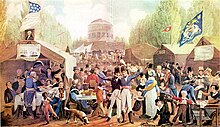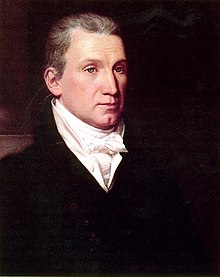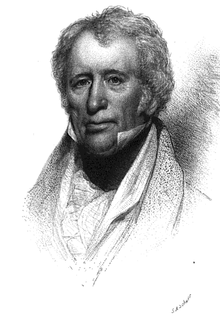Era Of Good Feelings Apush
| Era of Skilful Feelings | |||
|---|---|---|---|
| 1817–1825 | |||
 Independence Day Celebration in Centre Square by John Lewis Krimmel, 1819 | |||
| President(s) | James Monroe | ||
| Primal events | Missouri Compromise Panic of 1819 Adams-Onis Treaty Monroe Doctrine | ||
| |||
The Era of Good Feelings marked a menstruation in the political history of the United States that reflected a sense of national purpose and a desire for unity among Americans in the aftermath of the War of 1812.[1] [two] The era saw the plummet of the Federalist Party and an cease to the bitter partisan disputes between information technology and the ascendant Democratic-Republican Party during the First Political party Arrangement.[3] [four] President James Monroe strove to downplay partisan affiliation in making his nominations, with the ultimate goal of national unity and eliminating political parties altogether from national politics.[ane] [5] [vi] The period is so closely associated with Monroe's presidency (1817–1825) and his administrative goals that his name and the era are virtually synonymous.[7]
During and after the 1824 presidential ballot, the Democratic-Republican Party split betwixt supporters and opponents of Jacksonian Republic, leading to the Second Political party System.
The designation of the period by historians every bit one of skillful feelings is often conveyed with irony or skepticism, as the history of the era was one in which the political temper was strained and divisive, peculiarly among factions within the Monroe administration and the Democratic-Republican Party.[3] [8] [nine]
The phrase Era of Good Feelings was coined by Benjamin Russell in the Boston Federalist newspaper Columbian Centinel on July 12, 1817, following Monroe's visit to Boston, Massachusetts, equally part of his adept-will tour of the United States.[7] [ten] [11]
Post-war nationalism [edit]
The Era of Good Feelings started in 1815 at the end of the War of 1812.[2] Exultation replaced the bitter political divisions between Federalists and Republicans, the North and South, and the East Coast cities and settlers on the American frontier. The political hostilities declined because the Federalist Party had largely dissolved after the fiasco of the Hartford Convention in 1814–15.[12] As a political party, Federalists "had collapsed as a national political strength".[13] [14] [15] The Democratic-Republican Party was nominally dominant, only in practise it was inactive at the national level and in near states.[16]
The era saw a trend toward national institutions that envisioned "a permanent federal role in the crucial arena of national development and national prosperity".[17] Monroe'due south predecessor, President James Madison, and the Republican Party, had come to capeesh – through the crucible of state of war – the expediency of Federalist institutions and projects, and prepared to legislate them under the auspices of John C. Calhoun and Henry Clay's American Organisation.[18] [19] [20] [21]
Madison announced this shift in policy with his Seventh Annual Message to Congress in December 1815, afterwards authorizing measures for a national banking company and a protective tariff on articles.[22] Vetoing the Bonus Neb on strict constructionist grounds, Madison nevertheless was determined, as had been his predecessor, Thomas Jefferson,[23] to meet internal improvements implemented with an amendment to the The states Constitution.[24] [25] Writing to Monroe, in 1817, Madison declared that "there has never been a moment when such a proposition to u.s.a. was so likely to be approved".[26] The emergence of "new Republicans" – undismayed past mild nationalist policies – anticipated Monroe'south "era of adept feelings" and a general mood of optimism emerged with hopes for political reconciliation.[27]
Monroe's landslide victory confronting Federalist Rufus Male monarch in the 1816 presidential election was and then widely predicted that voter turnout was low.[28] [29] A spirit of reconciliation between Republicans and Federalists was well underway when Monroe assumed office in March 1817.[3] [30]
Monroe and political parties [edit]

President James Monroe, portrait by John Vanderlyn, 1816
As president, Monroe was widely expected to facilitate a rapprochement of the political parties in order to harmonize the state in a common national outlook, rather than party interests. Both parties exhorted him to include a Federalist in his cabinet to symbolize the new era of "oneness" that pervaded the nation.[1] [3]
Monroe reaffirmed his conviction that the Federalist Party was committed to installing a monarch and overthrowing republican forms of government at the first opportunity.[31] He stated that if he appointed a Federalist, he would prolong their inevitable pass up and fall, and that his administration would never allow itself to become tainted with Federalist ideology.[32]
Monroe stated that his drive to eliminate the Federalists was office of his entrada to eliminate party associations altogether from national politics, including his ain Republican party. All political parties, he wrote, were incompatible with complimentary government by their very nature. He worked to deflate the Federalist Party through fail. Federalists were denied political patronage, authoritative appointments, and federal back up. Monroe indicated that he wished to eradicate Federalists from positions of political power, both Federal and State, especially in its New England strongholds. He believed that any expression of official approving would only encourage hope for a Federalist revival, and this he could not bide.[33]
Some historians believe that Monroe reduced political party politics, evidenced by his unopposed run in the 1820 presidential ballot. The Federalists ran no candidate to oppose him, running only a vice-presidential candidate, Richard Stockton. Monroe and his vice president Daniel D. Tompkins would have won reelection unanimously through the electoral higher, had at that place non been a handful of faithless electors; ane presidential elector bandage his vote for John Quincy Adams, while a handful of electors (more often than not onetime Federalists) bandage votes for a number of Federalist candidates for Vice President. It remains the last presidential election in which a candidate ran essentially unopposed.[ commendation needed ]
The Great Goodwill Tour and national encompass of republicanism [edit]

Benjamin Russell is credited with coining the term "Era of Good Feelings" in 1817
The nearly perfect expression of the Era of Practiced Feelings was Monroe's country-broad Goodwill tour in 1817 and 1819. His visits to New England and to the Federalist stronghold of Boston, Massachusetts, in particular, were the most significant of the bout.[34] Hither, the descriptive phrase "Era of Adept Feelings" was bestowed past a local Federalist journal.
The President'southward physical appearance, wardrobe and personal attributes were decisive in arousing skilful feelings on the bout. He donned a Revolutionary State of war officer'southward uniform and tied his long, powdered hair in a queue according to the old-fashioned style of the 18th century.[35] "Tall, rawboned, venerable", he made an "amusing" impression and had a good bargain of amuse and "nigh men immediately liked him ... [in] manner he was rather formal, having an innate sense of nobility, which allowed no one to take liberties. Still in spite of his formality, he had the ability to put men at their ease by his courtesy, lack of condescension, his frankness, and what his contemporaries looked upon as the essential goodness and kindness of heart which he always radiated."[36] [37]
Monroe's visit to Boston elicited a huge outpouring of nationalist pride and expressions of reconciliation. New England Federalists were peculiarly eager to demonstrate their loyalty afterwards the debacle of the Hartford Convention. Amongst the festivities – banquets, parades, receptions – many took the opportunity to brand the most "explicit and solemn declarations" to remove, as Monroe wrote afterwards, "impressions of that kind, which they knew existed, and to get dorsum into the great family of the wedlock".[38] Abigail Adams dubbed the catharsis an "expiation."[37]
Here, in the heart of Federalist territory, Monroe gained the primary goal of his tour; in issue, permitting "the Federalists by solemn public demonstrations to reaffirm their loyalty to the government and their acceptance of Republican control".[34] Even in this atmosphere of contrition, Monroe was assiduous in fugitive any remarks or expressions that might chasten or humiliate his hosts. He presented himself strictly as the head of state, and not as the leader of a triumphant political party.[37]
In the ensuing years the New England states capitulated, and all but Massachusetts were in Republican Party easily. De-Federalization was virtually complete by 1820 and the appointment of former Federalist Party members seemed in order; still, Monroe feared a backlash even at this avant-garde stage in the process of amalgamation. Most anti-Federalist sentiments were political posturing, but Monroe was not and then secure of back up for his domestic and strange programs and was concerned at the mounting hostilities over the upcoming presidential contest in 1824, a purely intraparty affair. Monroe'due south final reconciling with the Federalists was never consummated.[38]
Failure of amalgamation and ascent of the Old Republicans [edit]
Monroe's success in mitigating party rancor produced an appearance of political unity, with almost all Americans identifying themselves as Republicans.[4] His near unanimous electoral victory for reelection in 1820 seemed to confirm this.[39]
Recognizing the danger of intraparty rivalries, Monroe attempted to include prospective presidential candidates and pinnacle political leaders in his administration. His cabinet comprised three of the political rivals who would vie for the presidency in 1824: John Quincy Adams, John C. Calhoun and William H. Crawford. A fourth, Andrew Jackson, held high war machine appointments.[40] Hither, Monroe felt he could manage the factional disputes and arrange compromise on national politics within administration guidelines.[38] His great disadvantage was that amalgamation deprived him of appealing to Republican "solidarity" that would have cleared the way for passage of his programs in Congress.
"From the moment that Monroe adopted as his guiding principle the proverb that he was head of a nation, non the leader of a party, he repudiated for all practical purposes the political party unity" that would accept served to establish his policies. The result was a loss of party subject.[4] [41] Absent-minded was the universal adherence to the precepts of Jeffersonianism: state sovereignty, strict structure and stability of Southern institutions. Erstwhile Republican critics of the new nationalism, amongst them John Randolph of Roanoke, Virginia, had warned that the abandonment of the Jeffersonian scheme of Southern preeminence would provoke a exclusive conflict, North and Southward, that would threaten the union.[4] Sometime president James Madison had cautioned Monroe that in any free regime, it was natural that political party identity would take shape.[40]
The disastrous Panic of 1819 and the Supreme Court's McCulloch v. Maryland reanimated the disputes over the supremacy of land sovereignty and federal ability, between strict construction of the US Constitution and loose construction.[42] The Missouri Crisis in 1820 made the explosive political conflict betwixt slave and free soil open up and explicit.[43] Only through the adroit handling of the legislation by Speaker of the Firm Henry Dirt was a settlement reached and disunion avoided.[thirteen] [44] [45]
With the decline in political consensus, it became imperative to revive Jeffersonian principles on the footing of Southern exceptionalism.[46] [47] The agrestal alliance, North and Due south, would exist revived to form Jacksonian Nationalism and the rise of the modernistic Democratic Political party.[48] The interlude of the Era of Good Feelings was at an stop.[31]
References [edit]
- ^ a b c Ammon 1971, p. 366
- ^ a b Wilentz 2008, p. 181
- ^ a b c d Ammon 1971, p. 4
- ^ a b c d Brown 1970, p. 23
- ^ Ammon 1971, p. 6
- ^ Dangerfield 1965, p. 24
- ^ a b Dangerfield 1965, p. 35
- ^ Remini 2002, p. 77
- ^ Dangerfield 1965, p. 32,35
- ^ Unger 2009, p. 271
- ^ Patricia L. Dooley, ed. (2004). The Early on Republic: Primary Documents on Events from 1799 to 1820. Greenwood. pp. 298ff. ISBN9780313320842.
- ^
- ^ a b Wilentz 2008, p. 42
- ^ Ammon 1971, p. 5
- ^ Schlesinger 1953, p. 9
- ^ McCormick, p. 14–16
- ^ Berstein & Issenberg 2010, p. 564
- ^ Remini 2002, p. 27
- ^ Dangerfield 1965, p. 5
- ^ Reynolds, David S. (2008). Waking Giant: America in the Historic period of Jackson . New York: Harper Collins. p. 9.
- ^ Wilentz 2008, p. 243
- ^ Dangerfield 1965, p. 5,6,20
- ^ Dangerfield 1965, p. eighteen
- ^ Schlesinger 1953, p. 19
- ^ Ammon 1971, p. 387
- ^ Dangerfield 1965, p. 19,20
- ^ Dangerfield 1965, p. twenty
- ^ McCormick, p. 102
- ^ Burns 1982, p. 264
- ^ Dangerfield 1965, p. 143
- ^ a b Dangerfield 1965, p. 3
- ^ Ammon 1971, p. five,half-dozen
- ^ Ammon 1971, p. half dozen,vii
- ^ a b Ammon 1971, p. 7
- ^ Wilentz 2008, p. 202
- ^ Dangerfield 1965, p. 22
- ^ a b c Ammon 1971, p. 8
- ^ a b c Ammon 1971, p. 9
- ^ Ammon 1971, p. 11
- ^ a b Ammon 1971, p. ten
- ^ Ammon 1971, p. 380
- ^ Dangerfield 1965, p. 97–98
- ^ Wilentz 2008, p. 217,219
- ^ Brown 1970, p. 25
- ^ Wilentz 2008, p. 240
- ^ Brown 1970, p. 23,24
- ^ Varon, Elizabeth R. (2008). Disunion!: The Coming of the American Civil War, 1789-1859. Chapel Hill: University of Northward Carolina Press. p. 39,40.
- ^ Dark-brown 1970, p. 22
Bibliography [edit]
- Ammon, Harry (1971). James Monroe: The Quest for National Identity . New York: McGraw-Hill.
- Brown, Richard H. (1970). "The Missouri Crisis, Slavery, and the Politics of Jacksonianism". South Atlantic Quarterly: 55–72. Cited in Gatell, Frank Otto, ed. (1970). Essays on Jacksonian America. New York City: Holt, Rinehart and Winston.
- Burns, James M. (1982). The Vineyard of Liberty . New York: Knopf.
- Berstein, Andrew; Issenberg, Nancy (2010). Madison and Jefferson. New York: Random Firm.
- Dangerfield, George (1965). The Awakening of American Nationalism: 1815-1828 . New York: Harper & Row.
- McCormick, Richard P, New Perspectives on Jacksonian Politics , cited in American Historical Review, LXV (January 1960), pp. 288–301.
- Remini, Robert V. (2002). John Quincy Adams. New York: Holt.
- Schlesinger, Arthur M. Jr (1953). The Age of Jackson. New York: Little, Brown.
- Unger, Harlow G. (2009). The final founding begetter: James Monroe and a nation's call to greatness. Cambridge, Massachusetts: Da Capo Press.
- Wilentz, Sean (2008). The Rise of American Commonwealth: Jefferson to Lincoln. New York: Horton.
Further reading [edit]
- George Dangerfield. The Era of Expert Feelings (1952).
- George Dangerfield. The Awakening of American Nationalism: 1815–1828 (1965).
- Howe, Daniel Walker. What Hath God Wrought: The Transformation of America, 1815–1848 (2008).
- Jenkins, Jeffery A., and Charles Stewart III. "Committee Assignments equally Side Payments: The Interplay of Leadership and Committee Development in the Era of Proficient Feelings." Annual meeting of the Midwest Political Science Clan 1998. online
- Kaplan, Lawrence South. "Jefferson every bit Anglophile: Sagacity or Senility in the Era of Skilful Feelings?" Diplomatic History 16.3 (1992): 487–494.
- Phillips, Kim T. "Democrats of the Sometime Schoolhouse in the Era of Adept Feelings." Pennsylvania Magazine of History and Biography 95.3 (1971): 363–382. online
- Silbey, Joel H. "The Incomplete World of American Politics, 1815–1829: Presidents, Parties and Politics in 'The Era of Practiced Feelings'." Congress & the Presidency: A Periodical of Capital Studies 11#1 (1984) 1–17.
- Sprague, Stuart Seely. "Town Making in the Era of Good Feelings: Kentucky 1814–1820." Register of the Kentucky Historical Order 72.4 (1974): 337–341. online
Principal sources [edit]
- Patricia L. Dooley, ed. (2004). The Early Democracy: Primary Documents on Events from 1799 to 1820. Greenwood. p. 298ff. ISBN9780313320842. text of Benjamin Russell editorial
- "President Madison's Veto Message". March 3, 1817. Archived from the original on May 2019.
- "President Monroe's Veto Bulletin". May 4, 1822. Archived from the original on May 2019.
- "President Monroe'due south Views of the President of the Usa on the Subject of Internal Improvements". May 4, 1822. Archived from the original on May 2019.
Era Of Good Feelings Apush,
Source: https://en.wikipedia.org/wiki/Era_of_Good_Feelings
Posted by: bentonalliat.blogspot.com


0 Response to "Era Of Good Feelings Apush"
Post a Comment